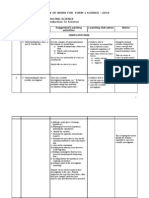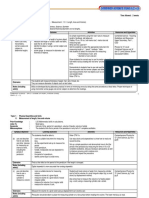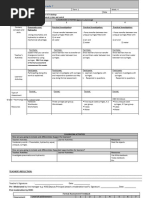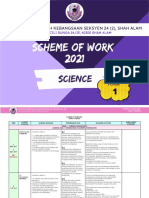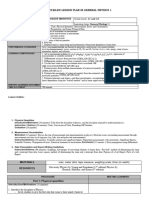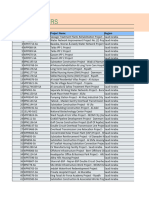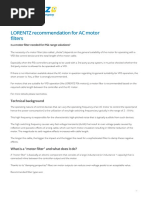0 ratings0% found this document useful (0 votes)
279 viewsRPH
RPH
Uploaded by
jesmani1. The document outlines a yearly plan for a Science Form 1 class with 13 weeks of lessons covering topics in introduction to science, cells, and matter.
2. Key concepts to be covered include the scientific method, physical quantities and units, mass vs weight, cell structure and function, organization of cells in organisms, and the definition of matter.
3. Each week focuses on 1-2 learning outcomes and includes the estimated time needed to cover the material through lessons, activities, and experiments.
Copyright:
Attribution Non-Commercial (BY-NC)
Available Formats
Download as DOCX, PDF, TXT or read online from Scribd
RPH
RPH
Uploaded by
jesmani0 ratings0% found this document useful (0 votes)
279 views6 pages1. The document outlines a yearly plan for a Science Form 1 class with 13 weeks of lessons covering topics in introduction to science, cells, and matter.
2. Key concepts to be covered include the scientific method, physical quantities and units, mass vs weight, cell structure and function, organization of cells in organisms, and the definition of matter.
3. Each week focuses on 1-2 learning outcomes and includes the estimated time needed to cover the material through lessons, activities, and experiments.
Original Title
rph
Copyright
© Attribution Non-Commercial (BY-NC)
Available Formats
DOCX, PDF, TXT or read online from Scribd
Share this document
Did you find this document useful?
Is this content inappropriate?
1. The document outlines a yearly plan for a Science Form 1 class with 13 weeks of lessons covering topics in introduction to science, cells, and matter.
2. Key concepts to be covered include the scientific method, physical quantities and units, mass vs weight, cell structure and function, organization of cells in organisms, and the definition of matter.
3. Each week focuses on 1-2 learning outcomes and includes the estimated time needed to cover the material through lessons, activities, and experiments.
Copyright:
Attribution Non-Commercial (BY-NC)
Available Formats
Download as DOCX, PDF, TXT or read online from Scribd
Download as docx, pdf, or txt
0 ratings0% found this document useful (0 votes)
279 views6 pagesRPH
RPH
Uploaded by
jesmani1. The document outlines a yearly plan for a Science Form 1 class with 13 weeks of lessons covering topics in introduction to science, cells, and matter.
2. Key concepts to be covered include the scientific method, physical quantities and units, mass vs weight, cell structure and function, organization of cells in organisms, and the definition of matter.
3. Each week focuses on 1-2 learning outcomes and includes the estimated time needed to cover the material through lessons, activities, and experiments.
Copyright:
Attribution Non-Commercial (BY-NC)
Available Formats
Download as DOCX, PDF, TXT or read online from Scribd
Download as docx, pdf, or txt
You are on page 1of 6
YEARLY PLAN – SCIENCE FORM 1
Learning Area/ Remarks
Week / Date Learning Outcomes
Learning Objectives 1A 1D 1G
List what he sees around him that is
related to science
Explain the importance of science in
Chapter 1: everyday life
Introduction to Science 160 min
1&2
1.1:: Name some careers in science such as:
4/1 – 15/1
Understanding that science a. Science teacher
is part of everyday life b. Doctors
c. Engineers
d. Environment scientists
40 min
State the steps in a scientific investigation
1.2::
3 / experiment
Understanding the steps in
18/1 – 22/1 Carry out a scientifi investigation
scientific investigation
200 min
State the physical quantities: length,
mass, time, temperature and electric
current
4 State the S.I. units and the corresponding
25/1 – 29/1 1.3:: symbols forthese physical quantities
- Knowing physical quantities State the symbols and values of prefixes
5 and their units for unitof length and mass: milli-, centi-
1/2 – 5/2 and kilo-
Identify and use appropriate prefixes in
the measurement of length and mass
160 min
Choose the right tool and measure length
in the context of an experiment
Estimate the area of regular and irregular
shapes using graph paper
80 min
Choose the right tool and measure the
6 1.4::
volume of liquid in the context of an
(8/2 – 12/2) Understanding the use of
experiment
measuring tools
Choose the right tool to measure body
temperature and the temperature of a
liquid
Determine the volume of solid using the
water displacement method
80 min
REVISION
7
TEST I
15//2 – 19/2
Determine the weight of an object
Explain the concept of weight
Explain the concept of mass
Determine the mass of an object
8 1.5::
40 min
(22/2 – 26/2) Understanding the concept
Explain the difference between mass and
of mass
weight
Apply the use of spring and beam/lever
balance in the context of an experiment
40 min
YEARLY PLAN – SCIENCE FORM 1
1.6:: Give examples of problems that may arise
Realising the importance of if standard units are not used
standard units in everyday
life 80 min
REVISION
9
(1/3 – 5/3)
- MID SEM EXAMINATION
10
(8/3 – 12/3)
15/3 – 19/3 MID SEM SCHOOL HOLIDAY
Identify that cells is the basic unit of living
things
40 min
Prepare slides following the proper
procedures
Use a microscope properly
Identify the general structure of animal
Chapter 2: cells and plant cells
11
Cell as a unit of life 80 min
22/3 – 26/3
2.1:: Draw the general strcutures of an animal
Understanding cells cell and a plant cell
Label the general structure of an animal PEKA II
cell and a plant cell
40 min
State the function of each structure
State the similarities and differences
between the two cells
40 min
State the meaning of unicellular and
2.2:: multicellular organisms
Understanding unicellular Give examples of unicellular and
and multicellular organisms multicellular organisms
40 min
State correctly the organisation of cells
Arrange in sequence organisation of cells
12 from the simple to the complex using the
29/3 – 2/4 terms cells, tissue, organ, system and
2.3::
organism
Understanding that cells
80 min
form tissues, organs and
Relate the organs to the system suitable
systems in the human body
for them
80 min
:. Name the different types of human cells and
their functions
2.4:: Explain why human beings are complex
Realising that humans are organisms
complex organisms 40 min
State that things have mass and occupy
space
13 Chapter 3:
Explain the meaning of matter
5/4 – 9/4 Matter
Relate things with matter 40 min
3.1::
Carry out an experiment to show that air,
Understanding that matter
water, soil and living things have mass
has mass and occupies space
and occupy space
80 min
YEARLY PLAN – SCIENCE FORM 1
State that matter is made up of particles
State the different states of matter
40 min
3.2::
Understanding the three State the arrangement of particles in the
states of matter three states of matter
State the differences in the movement of
particles in the three states of matter
14 80 min
12/4 – 16/4 Define density
40 min
Explain why some objects and liquids float
3.3::
Solve simple problems related to density
Understanding the concept
80 min
of density
Carry out activities to explore the
densities of objects and liquids
80 min
Describe how man uses the different
states of matter
Describe how man applies the concept of
15
3.4:: density
19/4 – 23/4
Appreciating the use of the Carry out an activity to explore the
properties of matter in daily applications of the concept of floating and
life sinking related to density
120 min
:.Describe how man uses the concept of
buoyancy
Chapter 4: List the resources on earth needed to
The variety of resources on sustain life
earth List the resources on earth used in
4.1:: everyday life
Knowing the different
resources on earth 40 min
State what elements, compounds and
mixtures are
16
Give examples of elements, compounds
26/4 – 30/4
and mixtures
80 min
State the differences between elements,
compounds and mixtures
Carry out activities to compare the
properties of different metals and non-
4.2:: metals
Understanding elements, 80 min
compounds and mixtures Classify elements as metals and non-
metals based on their characteristics
Give examples of metals and non-metals
Carry out activities to separate the
17 components of a mixture
3/5 – 7/5 200 min
:. Carry out experiment to separate different
mixtures
:. Compare and contrast mixture and compound
4.3:: Explain the importance of variety of
18 Appreciating earth’s resources to man
10/5 – 14/5 the importance State the meaning of the preservation
of the variety and conservation of resources on earth
YEARLY PLAN – SCIENCE FORM 1
of earth’s State the importance of the preservation
resources to and conservation of resources on earth
man. Practise reducing the use, reusing and
recycling of materials
80 min
State what air is made up of
Explain why air is a mixture
State the average percentage of nitrogen,
Chapter 5:
oxygen and carbon dioxide in air
The air around us
Carry out ativities to show:
5.1::
i. The percentage of oxygen in air
Understanding the
ii. That air contains water vapour,
composition of air
microorganisms and dust
120 min
:. State the constituents of air
19
REVISION
17/5 – 21/5
20
24/5 – 28/5
- MID YEAR EXAMINATION
21
31/5 – 4/6
7/6 – 18/6 MID YEAR SCHOOL HOLIDAY
List the properties of oxygen and carbon
dioxide
5.2:: 40 min
22
Understanding the Identify oxygen and carbon dioxide based
21/6 – 25/6
properties of oxygen and on their properties
carbon dioxide Choose a suitable test for oxygen and
carbon dioxide
160 min
State that energy, carbon dioxide and
water vapour are the products of
respiration
Relate that living things use oxygen and
give out carbon dioxide during respiration
80 min
Compare and contrast the content of
5.3::
oxygen in inhaled and exhaled air in
Understanding that oxygen
humans
is needed in respiration
23 80 min
28/6 – 2/7 State that oxygen is needed for
- respiration
24 Carry out an experiment to show that
5/7 – 9/7 living things use oxygen and give out
carbon dioxide during respiration
80 min
State what combustion is
State that oxxygen is needed for
5.4:: combustion
Understanding that oxygen List the products of combustion
is needed in combustion Carry out experiments to investigate
combustion
160 min
25 5.5:: Explain what air pollution is
12/7 – 16/7 Analysing the effects of the List examples of air pollution
YEARLY PLAN – SCIENCE FORM 1
pollution List the sources of air pollution
Describe the effects of air pollution
Explain the steps needed to prevent and
control air pollution
160 min
REVISION
26
TEST II
19/7 – 23/7
Describe how life would be without clean
5.6:: air
Realising the importance of Suggest ways to keep the air clean
keeping the air clean Practise habits that keep the air clean
40 min
List the various forms of energy
27 List the various sources of energy
26/7 – 30/7 Chapter 6: Identify energy changes
Souces of energy Identify the sun as the primary source of
6.1:: energy
Understanding various forms Carry out activities to investigate energy
and sources of energy change from potential to kinetic energy
and vice versa
160 min
Define renewable and non-renewable
sources of energy
6.2:: Group the various sources of energy into
28
Understanding renewable renewable and non-renewable energy
2/8 – 6/8
and non-renewable energy Explain why we need to conserve energy
Suggest ways to use energy efficiently
240 min
Describe the importance of conserving
6.3:: energy sources
29
Realising the importance of Explain the use and management of
9/8 – 13/8
conserving energy sources energy sources
160 min
State that the sun gives out heat
State other sources of heat
Chapter 7: State that heat is a form of energy
Heat Give examples of the uses of heat
7.1:: 200 min
Understanding heat as a State the meaning of temperature
form of energy State the differences between heat and
temperature
160 min
30
State that heat causes solids, liquids and
16/8 – 20/8
gases to expand and contract
-
40 min
32
State that heat flows in three different
30/8 – 3/9
ways (conduction, convection and
7.2:: radiation)
Understanding heat flow 80 min
and its effect State that heat flow from hot to cold
Give examples of heat flow in natural
phenomena
State what a heat conductor is
State what a heat insulator is
120 min
33 SCHOOL HOLIDAY
YEARLY PLAN – SCIENCE FORM 1
6/9 – 10/9
List the uses of heat conductors and heat
7.2:: insulators in daily life
34
Understanding heat flow Carry out an experiment to investigate
13/9 – 17/9
and its effect different materials as heat insulators
200 min
State the change in state of matter in
physical processes
Explain that change in state of matter
7.3::
35 involves the absorption and release of
Analysing the effect of heat
20/9 – 24/9 heat
on matter
Give examples of daily observations
which show a change in state of matter
200 min
Explain with examples the use of
expansion and contraction of matter in
7.4::
daily life
Applying the principle of
160 min
expansion and contraction
Apply the principle of expansion and
of
contraction of matter in solving simple
matter
36 problems
27/9 – 1/10 160 min
- State that dark, dull objects absorb heat
38 better than white, shiny objects
7.5::
11/10 – 15/10 State that dark, dull objects give out heat
Understanding that dark,
better than white, shiny objects
dull
120 min
objects absorb and give out
Carry out experiments to investigate heat
heat better
absorption and heat release
80 min
REVISION
39
18/10 – 22/10
- FINAL EXAMINATION
40
25/10 – 29/10
41
DISCUSSION
1/11 – 5/11
7.6:: Put into practice the principle of heat
42
Appreciating the benefits of flow to provide comfortable living
8/11 – 12/11
heat flow
43
SCIENCE ACTIVITIES
15/11 – 19/11
You might also like
- Scheme of Work For Form 1 ScienceDocument22 pagesScheme of Work For Form 1 ScienceJila NfmNo ratings yet
- SINGLE PHASE PWM RECTIFIER by L'ubom Ir GRMAN 4 - 111-4Document7 pagesSINGLE PHASE PWM RECTIFIER by L'ubom Ir GRMAN 4 - 111-4deepak_gupta_pritiNo ratings yet
- RPT Science FRM 1Document9 pagesRPT Science FRM 1yunianisNo ratings yet
- RPT Science F1 2018Document22 pagesRPT Science F1 2018zulhariszan abd mananNo ratings yet
- R PT Science FRM 12013Document9 pagesR PT Science FRM 12013bartNo ratings yet
- Rancangan Harian Science T1 - 2021Document14 pagesRancangan Harian Science T1 - 2021g-90227065No ratings yet
- Yearly Lesson Plan SC f1Document14 pagesYearly Lesson Plan SC f1noor mazitaNo ratings yet
- Grade 7 - Integrated Science Consolidated CurriculumDocument10 pagesGrade 7 - Integrated Science Consolidated CurriculumReshma MohabeirNo ratings yet
- Yearly Lesson Plan SC f1Document16 pagesYearly Lesson Plan SC f1Mary IdrusNo ratings yet
- Sow For Combined Science Year 9 (2+2 Programme) v2 - 2 YearsDocument80 pagesSow For Combined Science Year 9 (2+2 Programme) v2 - 2 YearsYenny TigaNo ratings yet
- Sow Combined Science Year 9 (2+3 Programme) v2 - 3 YearsDocument56 pagesSow Combined Science Year 9 (2+3 Programme) v2 - 3 YearsYenny Tiga100% (2)
- Yearly Lesson Plan Science Form 1Document7 pagesYearly Lesson Plan Science Form 1Nurul AzuwinNo ratings yet
- SLG 4.1 - The International System of Measurement (Part I and Part II)Document12 pagesSLG 4.1 - The International System of Measurement (Part I and Part II)mjppacalangotNo ratings yet
- 2021-2022 1-5 GTHS Ombe Phy - Chem Schemes-1Document46 pages2021-2022 1-5 GTHS Ombe Phy - Chem Schemes-1Akama Makia EmmanuelNo ratings yet
- SOS - Physics1Document8 pagesSOS - Physics1baneenfatima705No ratings yet
- RPT SCIENCE FORM 1 2024Document17 pagesRPT SCIENCE FORM 1 2024salwaabdullahNo ratings yet
- Rancangan Pengajaran Tahunan Science Form 1 2019 (Dlp-English)Document14 pagesRancangan Pengajaran Tahunan Science Form 1 2019 (Dlp-English)Nur IzzyNo ratings yet
- Yearly Lesson Plan Phy f4 2018Document16 pagesYearly Lesson Plan Phy f4 2018TS ShongNo ratings yet
- RPT Science Form 1 2020Document29 pagesRPT Science Form 1 2020Norshamsiah SamsudinNo ratings yet
- Sow Combined Science Year 9 - 2+3 Programme - v2Document37 pagesSow Combined Science Year 9 - 2+3 Programme - v2Airul YantiNo ratings yet
- Chapter 1: Introduction To Scientific Investigation: Theme 1: Scientific Methodology (12 Hours)Document14 pagesChapter 1: Introduction To Scientific Investigation: Theme 1: Scientific Methodology (12 Hours)Anonymous ESQwNOtfe6No ratings yet
- SMK Seri Kembangan Yearly Lesson Plan 2019 Science KSSM Form 1Document16 pagesSMK Seri Kembangan Yearly Lesson Plan 2019 Science KSSM Form 1ryeNo ratings yet
- SMK Datuk Onn Butterworth Rancangan Pelajaran Tahunan 2019 Mata Pelajaran Fizik Tingkatan 4Document17 pagesSMK Datuk Onn Butterworth Rancangan Pelajaran Tahunan 2019 Mata Pelajaran Fizik Tingkatan 4Izzat FuatNo ratings yet
- Yearly Plan f1 SC DLP 2022Document29 pagesYearly Plan f1 SC DLP 2022NURULKAMILAH KHAIRIRNo ratings yet
- RPH Week 4Document16 pagesRPH Week 4mexfloziaNo ratings yet
- Form 1 Scheme 2019 Term 1 1Document10 pagesForm 1 Scheme 2019 Term 1 1Tapiwa Trust Kanyai100% (2)
- Lesson Plan For Form Four Physics: Learning Area: 1. Introduction To PhysicsDocument22 pagesLesson Plan For Form Four Physics: Learning Area: 1. Introduction To Physicsahchin5No ratings yet
- SMK Tinggi Bukit Mertajam, 77, Jalan Sri Bukit, 14000 Bukit Mertajam, Pulau PinangDocument21 pagesSMK Tinggi Bukit Mertajam, 77, Jalan Sri Bukit, 14000 Bukit Mertajam, Pulau PinangPei TingNo ratings yet
- Ylp Remove 2018Document5 pagesYlp Remove 2018mexfloziaNo ratings yet
- Week 1Document13 pagesWeek 1angelicaamormanzanoNo ratings yet
- BIO ANNUAL PLAnDocument8 pagesBIO ANNUAL PLAnaasss22famNo ratings yet
- Unit 1 CH 1 Lesson 1measuring UnitsDocument2 pagesUnit 1 CH 1 Lesson 1measuring UnitsAhmed HassanNo ratings yet
- Physics - Grade 9 - Christmas Term 2022-2023Document4 pagesPhysics - Grade 9 - Christmas Term 2022-2023nthsjamaicaNo ratings yet
- College SyllabusDocument14 pagesCollege SyllabusJosephine SarvidaNo ratings yet
- RPT 2024 Biology KSSM t4 EnglishDocument30 pagesRPT 2024 Biology KSSM t4 EnglishFatin NazihaNo ratings yet
- Jul. 25/2010 Ph0101 Lecture Scheme/Plan Physics For TechnologistsDocument8 pagesJul. 25/2010 Ph0101 Lecture Scheme/Plan Physics For TechnologistsSURESH SURAGANINo ratings yet
- RPT Science Form 1 2023Document16 pagesRPT Science Form 1 2023fiezah halimNo ratings yet
- Meteorology and Oceanography 1Document11 pagesMeteorology and Oceanography 1katherineyniegoNo ratings yet
- Tle-Dll Grade 7 (Week 3) January 27-31,2020Document2 pagesTle-Dll Grade 7 (Week 3) January 27-31,2020Josephine Rivera100% (2)
- RPT SC Year 3 (DLP) 2023-2024Document25 pagesRPT SC Year 3 (DLP) 2023-2024Nur FathirahNo ratings yet
- Ylp Science f1 2024 Fara Asrab GoayDocument17 pagesYlp Science f1 2024 Fara Asrab Goayg-90227065No ratings yet
- General Physics Practical IDocument3 pagesGeneral Physics Practical IEnoch YaoNo ratings yet
- Technology Lesson Plan Term 1 Week 4 of 2024Document2 pagesTechnology Lesson Plan Term 1 Week 4 of 2024Maphothego MogodiNo ratings yet
- CEng 138 - GGD Sylllabus UPDATEDDocument10 pagesCEng 138 - GGD Sylllabus UPDATEDJuan Gilio SuarezNo ratings yet
- Measurements: by CHED On May 28, 2020Document5 pagesMeasurements: by CHED On May 28, 2020Raze De La CroixNo ratings yet
- Science Physics 5124Document24 pagesScience Physics 5124Susan MweembaNo ratings yet
- Sow f1 Igcse Phy 2021Document21 pagesSow f1 Igcse Phy 2021Immy MaysmeekaNo ratings yet
- RPT Science Form 1 2017 SemesraDocument15 pagesRPT Science Form 1 2017 Semesracikgu ayu100% (3)
- General Chemistry 1Document83 pagesGeneral Chemistry 1ibano626No ratings yet
- 3rd Quarter Examination Grade 7 Household Services TOSDocument3 pages3rd Quarter Examination Grade 7 Household Services TOSAngellie Arsaga AlaparNo ratings yet
- Q1 LC7.1Document45 pagesQ1 LC7.1elenalouisjamesNo ratings yet
- PM (5ed) - SOW - C01Document3 pagesPM (5ed) - SOW - C01saniedhaNo ratings yet
- Integrated ScienceDocument26 pagesIntegrated ScienceAris TotleNo ratings yet
- Grade 8 - Integrated Science Consolidated CurriculumDocument12 pagesGrade 8 - Integrated Science Consolidated Curriculumshonaishot hottieNo ratings yet
- Yearly Plan F1 SC 2022Document29 pagesYearly Plan F1 SC 2022DAYANG AZWA NADIA BINTI AWG AHMAD ISHAK MoeNo ratings yet
- Rancangan Pengajaran Tahunan Form 1 Science DLP 2021Document19 pagesRancangan Pengajaran Tahunan Form 1 Science DLP 2021SITI SHAHARZAD BINTI WAHAB MoeNo ratings yet
- General PhysicsDocument23 pagesGeneral PhysicsSandraNo ratings yet
- Yearly Lesson Plan: Science Form 1 2019 KSSMDocument18 pagesYearly Lesson Plan: Science Form 1 2019 KSSMSITI NURSYIFA BINTI ROZALI MoeNo ratings yet
- SMK Seri Hartamas Scheme of Work For Form 4 Physics Yearly Teaching Plan 2016 Learning Area: 1. Introduction To PhysicsDocument19 pagesSMK Seri Hartamas Scheme of Work For Form 4 Physics Yearly Teaching Plan 2016 Learning Area: 1. Introduction To Physicssyam123456789No ratings yet
- Platinum Physical Science Grade 8 - Term PlannerDocument9 pagesPlatinum Physical Science Grade 8 - Term PlannereduclinicgroupoftutorsNo ratings yet
- Jadual Pra SPM 2012Document1 pageJadual Pra SPM 2012jesmaniNo ratings yet
- Word Search Lower Form (F2 & F3)Document1 pageWord Search Lower Form (F2 & F3)jesmaniNo ratings yet
- Word Search Form 1Document1 pageWord Search Form 1jesmaniNo ratings yet
- Teka Silang Kata Sains t5Document1 pageTeka Silang Kata Sains t5jesmaniNo ratings yet
- 3 Effect of Heat On GasesDocument10 pages3 Effect of Heat On GasesjesmaniNo ratings yet
- Journal of Engineering and Technology For Industrial ApplicationsDocument69 pagesJournal of Engineering and Technology For Industrial Applicationsrodden chikonzoNo ratings yet
- Consumer Behavior: Sessional AssignmentDocument17 pagesConsumer Behavior: Sessional Assignmentammar afridiNo ratings yet
- Research On Power Flow Algorithm of Power System With UPFCDocument5 pagesResearch On Power Flow Algorithm of Power System With UPFCmonika meenaNo ratings yet
- Model: GFW-100 T5Document15 pagesModel: GFW-100 T5Dhrubajyoti Bora100% (1)
- Renewable - Resources - and - Potentials - 20.12.2016 Ministry of PowerDocument32 pagesRenewable - Resources - and - Potentials - 20.12.2016 Ministry of Powernana yawNo ratings yet
- IPhO Olimpiadas Internacionais de Fisica 1967 A 2013 Totalmente Resolvidas English VersionDocument1,443 pagesIPhO Olimpiadas Internacionais de Fisica 1967 A 2013 Totalmente Resolvidas English VersionCicero TiagoNo ratings yet
- User Manual For Flexible Solar Panel 2021Document3 pagesUser Manual For Flexible Solar Panel 2021DaNo ratings yet
- Hazards Identification and Risk Assessment in Thermal Power Plant IJERTV3IS040583 PDFDocument4 pagesHazards Identification and Risk Assessment in Thermal Power Plant IJERTV3IS040583 PDFKalai Arasan100% (2)
- Hierarchical Structure and Bus Voltage Control of DC MicrogridDocument13 pagesHierarchical Structure and Bus Voltage Control of DC MicrogridAli KarasukogluNo ratings yet
- En T&D Sil-G Data-Sheet Rev1Document2 pagesEn T&D Sil-G Data-Sheet Rev1mr_badihiNo ratings yet
- Variable-Frequency Drives Upgrade Reactor Circulating PumpsDocument4 pagesVariable-Frequency Drives Upgrade Reactor Circulating PumpsDaniloGarciaMuñozNo ratings yet
- Cars in The 21st C - Practice Reading TextDocument3 pagesCars in The 21st C - Practice Reading TextNoha El-SherifNo ratings yet
- Thermodynamic Optimization of Bottoming CycleDocument15 pagesThermodynamic Optimization of Bottoming CycleStjepkoKatulić100% (1)
- Project List Export 10-10-2023Document12 pagesProject List Export 10-10-2023Muhammad AzharuddinNo ratings yet
- Implementation of Wide Area Monitoring System For Interconnected Power System in IndiaDocument6 pagesImplementation of Wide Area Monitoring System For Interconnected Power System in IndiaRamesh KannanNo ratings yet
- Compressible FlowDocument17 pagesCompressible FlowkhumisoNo ratings yet
- Assignment No. 2 (BOE-304)Document2 pagesAssignment No. 2 (BOE-304)Rahul SengarNo ratings yet
- Training ReportDocument78 pagesTraining Reporttiranuom100% (5)
- Electrical Machines: IES Electrical Engineering Topic Wise QuestionsDocument78 pagesElectrical Machines: IES Electrical Engineering Topic Wise QuestionsahmedNo ratings yet
- EV PRND Drivers FinalDocument47 pagesEV PRND Drivers FinalResearchtimeNo ratings yet
- Tech FRTDocument8 pagesTech FRTNaveen BosNo ratings yet
- Lorentz Ps2 600 Cs FDocument6 pagesLorentz Ps2 600 Cs FSINES FranceNo ratings yet
- Comparative Study of Interconnection Schemes of Modules in Solar PV Array NetworkDocument7 pagesComparative Study of Interconnection Schemes of Modules in Solar PV Array NetworkRexus GamingNo ratings yet
- Power Supply Systems Spds Type 2: Dehnguard® Modular DG M TT 275 FMDocument2 pagesPower Supply Systems Spds Type 2: Dehnguard® Modular DG M TT 275 FMMohammad NasarNo ratings yet
- docID 1081 en Lorentz Recommendation For Ac Motor FiltersDocument4 pagesdocID 1081 en Lorentz Recommendation For Ac Motor FiltersDavid LaraNo ratings yet
- 7.voltage Drop and Power Loss CalculationDocument16 pages7.voltage Drop and Power Loss CalculationImjusttryingtohelp100% (1)
- Chapter 1.1 Introduction To Natural Gas EngineeringDocument27 pagesChapter 1.1 Introduction To Natural Gas EngineeringhugoNo ratings yet
- Marine LED LightsDocument7 pagesMarine LED LightsSagar TanksaliNo ratings yet
- Section A: Course Details: Unikl XyzDocument3 pagesSection A: Course Details: Unikl XyzjohnjabarajNo ratings yet
